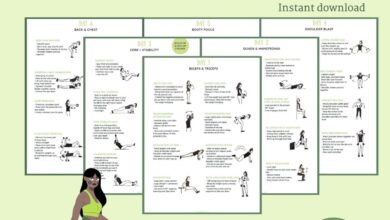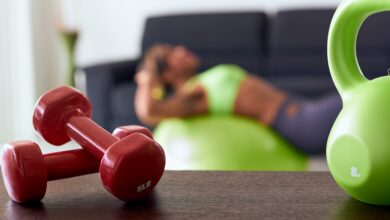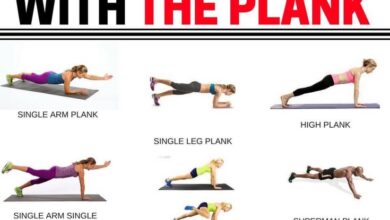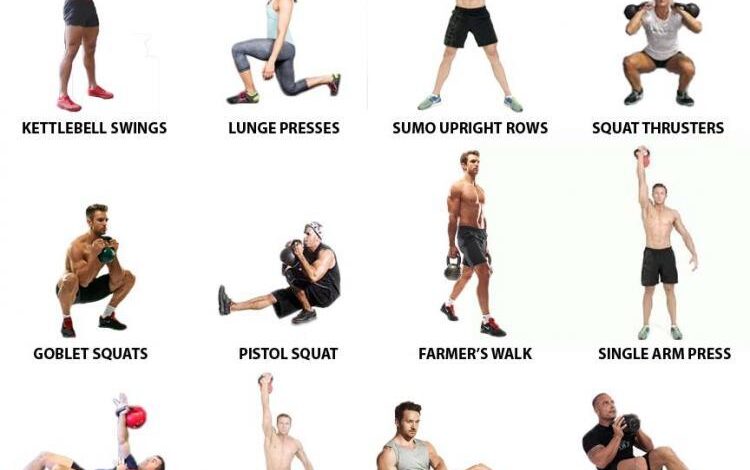
9 Kettlebell Exercises Everyone Should Try
9 Kettlebell Exercises Everyone Should Try is your guide to unlocking a world of strength, power, and fitness. Kettlebells, with their unique design and versatility, have become a staple in many fitness routines, and for good reason. These cast-iron weights offer a dynamic and effective way to work your entire body, whether you’re a seasoned athlete or just starting your fitness journey.
Kettlebell exercises are not only accessible for everyone, but they also provide a plethora of benefits. From improving cardiovascular health and core stability to boosting strength, flexibility, and coordination, kettlebell training can help you achieve your fitness goals. So, grab a kettlebell and get ready to explore these 9 exercises that will transform your workout routine.
Kettlebell Exercises: A Comprehensive Guide for Everyone
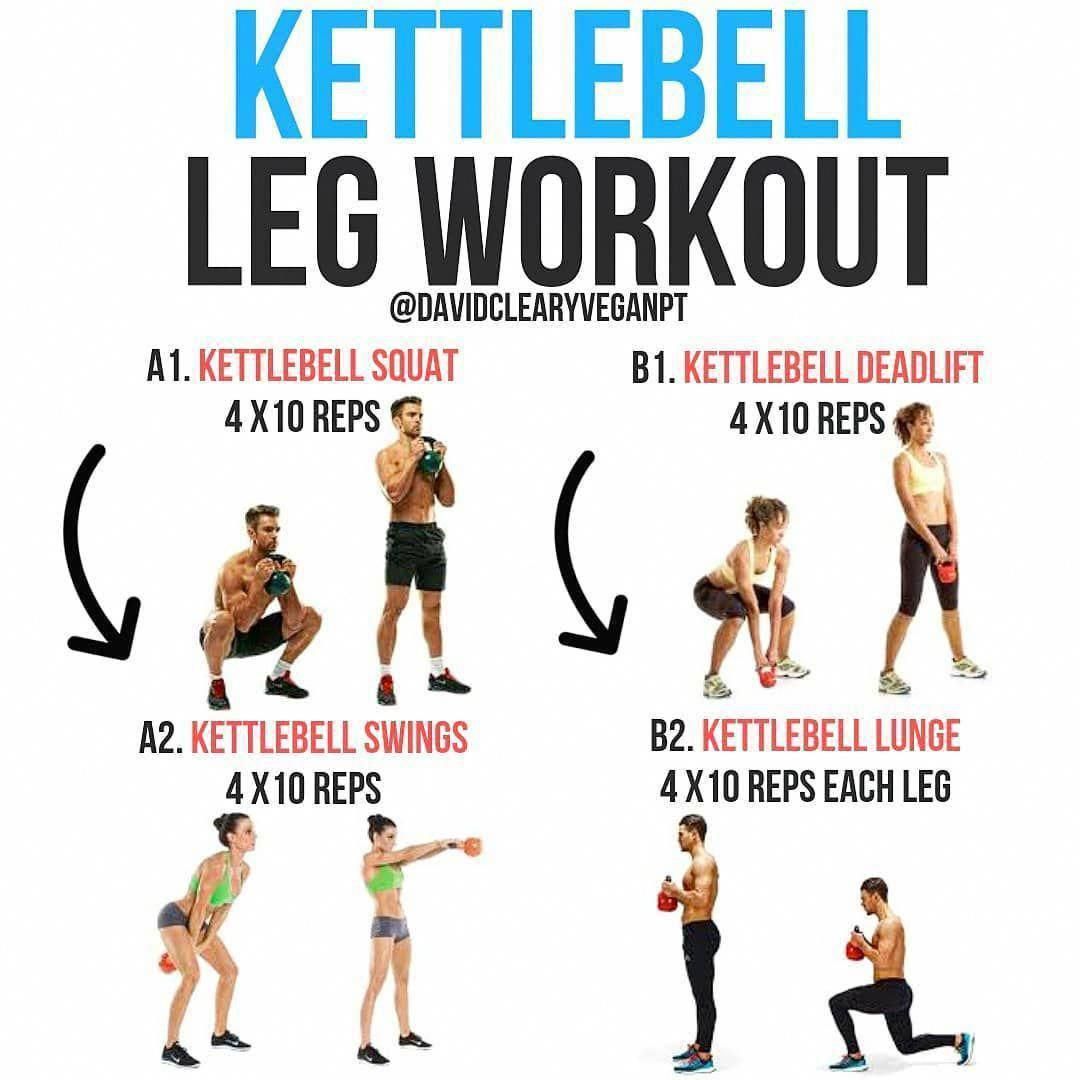
Kettlebell exercises are a dynamic and versatile form of training that offers a wide range of benefits for individuals of all fitness levels. These exercises engage multiple muscle groups simultaneously, promoting overall strength, power, and endurance. Unlike traditional weightlifting, kettlebell exercises emphasize functional movements, mimicking real-life activities and improving coordination, balance, and flexibility.
Benefits of Kettlebell Exercises
Kettlebell exercises provide numerous benefits for both beginners and experienced athletes. These benefits include:
- Improved Strength and Power: Kettlebell exercises engage multiple muscle groups, promoting overall strength and power development. The dynamic nature of these exercises enhances muscle activation and coordination, leading to greater force production. For example, the kettlebell swing engages the glutes, hamstrings, and core muscles, promoting hip and leg power.
- Enhanced Cardiovascular Health: Kettlebell exercises elevate your heart rate, improving cardiovascular health and endurance. The dynamic nature of these exercises demands constant movement, leading to increased calorie expenditure and fat burning. Studies have shown that kettlebell training can effectively improve cardiovascular fitness, comparable to other forms of cardio exercise.
- Increased Flexibility and Mobility: Kettlebell exercises promote flexibility and mobility by engaging a wide range of motion. The dynamic nature of these exercises stretches muscles and improves joint range of motion, reducing stiffness and improving overall body movement.
- Improved Core Strength: Kettlebell exercises require constant core engagement to maintain stability and control during movement. The dynamic nature of these exercises challenges the core muscles, promoting strength and stability, which is essential for daily activities and athletic performance.
- Enhanced Coordination and Balance: Kettlebell exercises demand coordination and balance, improving body control and stability. The dynamic nature of these exercises challenges the body to maintain balance and control, enhancing overall coordination and agility.
Versatility and Effectiveness of Kettlebells
Kettlebells are a versatile and effective training tool suitable for individuals of all fitness levels. Their versatility stems from the following factors:
- Wide Range of Exercises: Kettlebells can be used for a wide range of exercises, targeting various muscle groups and fitness goals. From basic swings and squats to advanced snatches and cleans, kettlebell exercises offer endless possibilities for challenging your body.
- Progressive Overload: Kettlebells allow for progressive overload, gradually increasing the weight or resistance to challenge your muscles and promote growth. This principle is essential for continuous improvement and achieving fitness goals.
- Functional Movements: Kettlebell exercises mimic real-life movements, promoting functional strength and improving everyday activities. These exercises engage multiple muscle groups simultaneously, enhancing coordination and balance, which are crucial for daily tasks and athletic performance.
- Space-Saving and Portable: Kettlebells are compact and portable, making them ideal for home workouts or traveling. You can easily store them in a small space and take them with you wherever you go, allowing for convenient and effective training sessions.
Kettlebell Swing
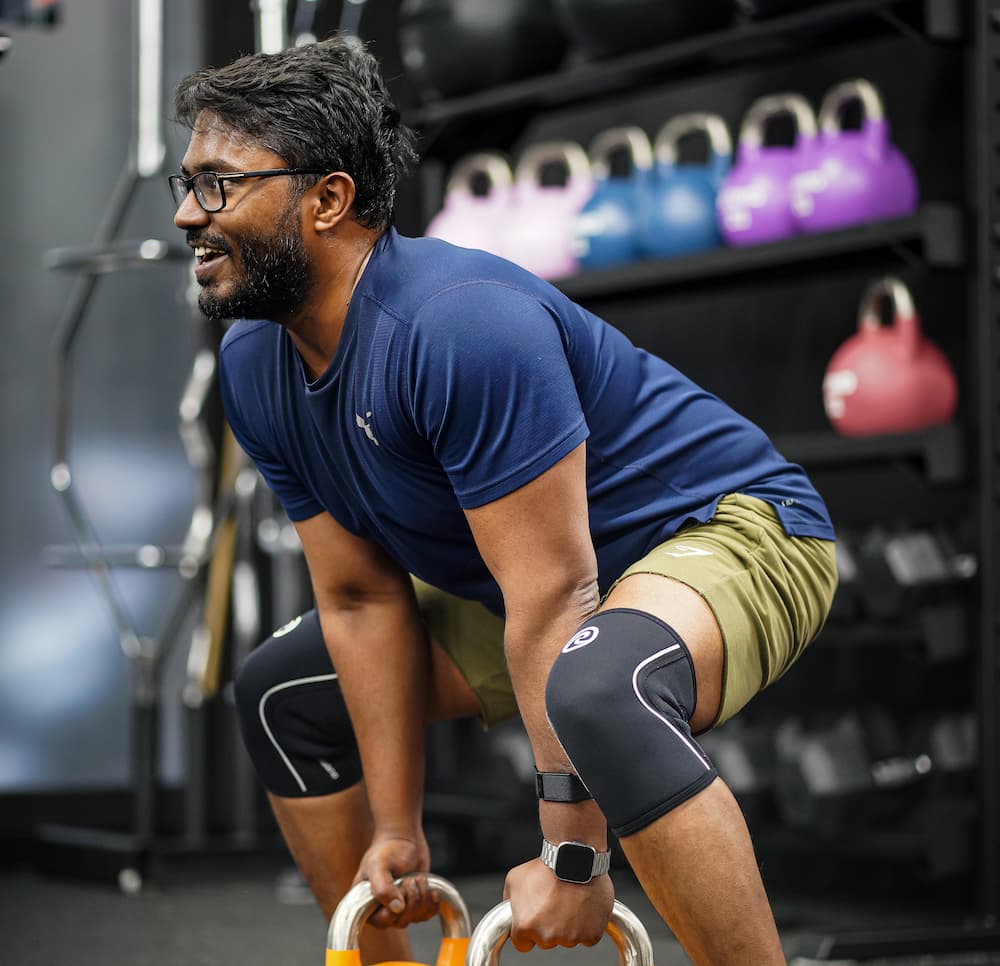
The kettlebell swing is a dynamic exercise that engages multiple muscle groups, making it a highly effective and versatile movement for enhancing strength, power, and cardiovascular health. It’s a fundamental kettlebell exercise that forms the foundation for many other advanced movements.
Proper Form and Technique
Proper form is crucial for maximizing the benefits of the kettlebell swing while minimizing the risk of injury. Here’s a step-by-step guide to performing a kettlebell swing correctly:
- Starting Position:Stand with your feet slightly wider than shoulder-width apart, toes pointed slightly outward. Hold the kettlebell in front of you with an overhand grip, slightly wider than shoulder-width. Keep your back straight, core engaged, and shoulders relaxed.
- Hip Hinge:Hinge at your hips, pushing your butt back and lowering the kettlebell between your legs. Keep your back straight and core engaged throughout the movement. Your knees should be slightly bent, but don’t let them go past your toes.
- Swing:Explosively drive your hips forward, keeping your back straight and core engaged. As you do this, swing the kettlebell up to shoulder height, using the momentum of your hips and legs. Your arms should remain relatively straight throughout the swing.
- Return to Starting Position:Allow the kettlebell to swing back down between your legs, using the momentum from the upward swing. As the kettlebell swings down, hinge at your hips again, controlling the movement with your core and glutes.
- Repeat:Continue the swinging motion, maintaining proper form and keeping your core engaged throughout the exercise.
Muscles Engaged, 9 kettlebell exercises everyone
The kettlebell swing engages a wide range of muscles, including:
- Posterior Chain:The glutes, hamstrings, and lower back are the primary movers in the kettlebell swing, responsible for generating the power and momentum of the movement.
- Core:The abdominal muscles, obliques, and transverse abdominis are essential for maintaining core stability and preventing back injuries.
- Upper Body:The lats, traps, and biceps are involved in stabilizing the kettlebell and controlling its movement.
Benefits of Kettlebell Swings
The kettlebell swing offers a multitude of benefits, including:
- Increased Power and Strength:The dynamic nature of the kettlebell swing recruits multiple muscle groups simultaneously, leading to significant increases in strength and power.
- Improved Cardiovascular Health:The explosive nature of the swing elevates your heart rate and improves cardiovascular endurance, making it a highly effective exercise for overall health.
- Enhanced Core Stability:The constant engagement of the core muscles during the swing improves core strength and stability, which is essential for overall functional fitness and injury prevention.
- Improved Flexibility and Mobility:The hip hinge motion involved in the kettlebell swing promotes flexibility and mobility in the hips and lower back, contributing to a greater range of motion.
Kettlebell Goblet Squat: 9 Kettlebell Exercises Everyone
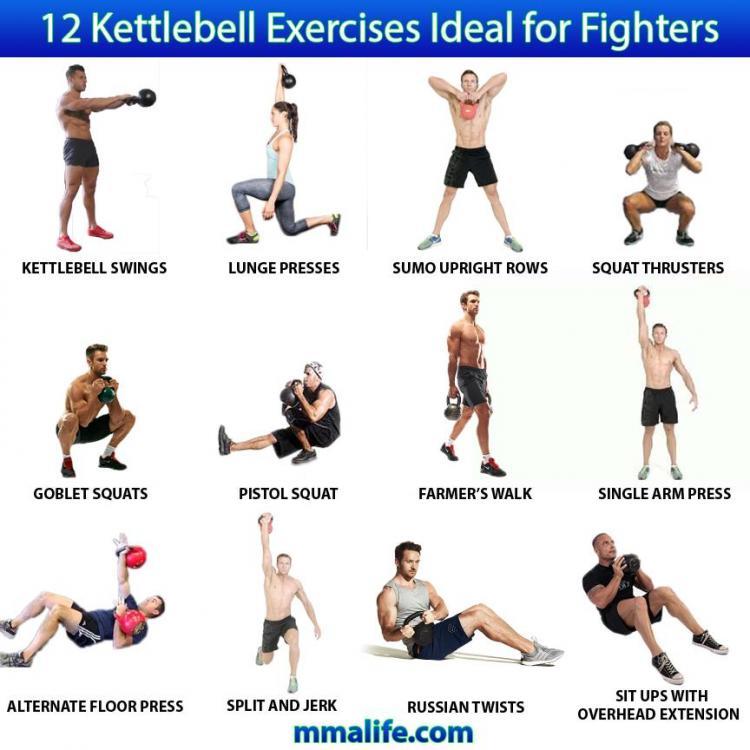
The kettlebell goblet squat is a fundamental exercise that targets your lower body muscles while enhancing flexibility and balance. It’s a versatile move suitable for individuals of all fitness levels, from beginners to experienced athletes.The goblet squat derives its name from the way you hold the kettlebell, similar to how you would hold a goblet.
This unique grip promotes a more upright torso position and encourages proper form, making it an excellent exercise for those starting their fitness journey.
Nine kettlebell exercises are a great way to build strength and endurance, and you can easily incorporate them into your workout routine. If you’re looking for a healthy way to enjoy pizza, check out 11 healthy pizzas under 400 calories for some tasty inspiration.
After your kettlebell workout, you’ll be ready to fuel up with a slice of delicious, healthy pizza.
Benefits of the Goblet Squat
The goblet squat offers a multitude of benefits, including:
- Increased Lower Body Strength: The goblet squat primarily targets the quadriceps, hamstrings, and glutes, building strength and power in your lower body. The weight distribution of the kettlebell in front of your body forces you to engage your core muscles for stability, contributing to overall strength development.
Mastering those 9 kettlebell exercises everyone should know can really amp up your workouts. But sometimes, staying motivated with meal prep can be a struggle. If you’re feeling stuck in a rut, check out these 6 proven ways to get out of a meal prep plateau to get back on track.
With a solid meal plan and those kettlebell moves, you’ll be crushing your fitness goals in no time!
- Improved Flexibility and Mobility: The goblet squat promotes hip and ankle flexibility, allowing for a deeper squat range of motion. This improved mobility can translate to better performance in other exercises and daily activities.
- Enhanced Balance and Stability: The goblet squat requires you to maintain balance with the weight held in front of your body. This constant engagement of your core and stabilizing muscles improves your overall balance and coordination.
Comparison to Other Squat Variations
The goblet squat stands out from other squat variations due to its unique advantages:
- Improved Form: The kettlebell’s position in front of your chest encourages a more upright torso, promoting proper squat form and reducing the risk of lower back strain. This makes it ideal for beginners or individuals with back issues.
- Increased Core Engagement: The weight distribution of the kettlebell forces your core to work harder to maintain stability, leading to a stronger core and improved overall posture.
- Versatility: The goblet squat can be modified for different fitness levels by adjusting the weight of the kettlebell. It’s a great exercise for both strength training and conditioning, making it adaptable to various workout goals.
Kettlebell Bent-Over Row
The kettlebell bent-over row is a versatile exercise that effectively targets your back muscles, promoting strength, stability, and improved posture. This exercise is a great addition to any workout routine, whether you’re a beginner or a seasoned lifter.
Mastering those 9 kettlebell exercises everyone should know takes dedication, and fueling your body with nutritious foods is key. For a tasty and healthy snack, check out these delicious ways to use chickpeas under 360 calories. Once you’ve got your energy levels up, you’ll be ready to tackle those kettlebell swings and snatches!
Proper Form and Technique
Performing the kettlebell bent-over row with proper form is crucial to maximize its benefits and minimize the risk of injury. Here’s a step-by-step guide:
- Stand with your feet hip-width apart, holding a kettlebell in each hand.Keep your back straight and your core engaged.
- Hinge at your hips, lowering your torso towards the floor.Maintain a slight bend in your knees and keep your back straight. Your shoulders should be lower than your hips.
- Let the kettlebells hang straight down from your shoulders.This is your starting position.
- Pull the kettlebells up towards your waist, keeping your elbows close to your body.Use your back muscles to lift the weight, not your arms.
- Pause at the top of the movement, squeezing your back muscles.
- Slowly lower the kettlebells back to the starting position.
Muscles Engaged, 9 kettlebell exercises everyone
The kettlebell bent-over row engages various muscle groups, primarily targeting your back:
- Latissimus dorsi:This large muscle on the back is responsible for pulling movements, like rowing and swimming. It helps with shoulder extension, adduction, and internal rotation.
- Trapezius:This muscle spans from the base of your skull to your mid-back. It helps with shoulder elevation, retraction, and depression.
- Rhomboids:These muscles are located between your shoulder blades. They help with scapular retraction, pulling the shoulder blades together.
- Biceps brachii:This muscle on the front of your upper arm assists with elbow flexion.
- Erector spinae:These muscles run along your spine and help with back extension and posture.
Benefits of Kettlebell Bent-Over Row
The kettlebell bent-over row offers numerous benefits for your back strength and overall fitness:
- Increased back strength:This exercise effectively targets the back muscles, leading to increased strength and power in pulling movements.
- Improved posture:By strengthening the back muscles, this exercise helps improve posture and reduce the risk of back pain.
- Enhanced core stability:The core muscles are engaged throughout the exercise, promoting stability and balance.
- Improved grip strength:Holding the kettlebells during the exercise strengthens your grip.
- Versatile exercise:The bent-over row can be modified to suit different fitness levels, making it suitable for beginners and advanced lifters alike.
Kettlebell Deadlift
The kettlebell deadlift is a versatile exercise that effectively targets multiple muscle groups, particularly in the posterior chain, which comprises the muscles along the back of your body. This exercise is a foundational movement for building overall strength, power, and functional fitness.
Benefits of the Kettlebell Deadlift
The kettlebell deadlift offers numerous benefits for individuals seeking to enhance their physical capabilities.
- Increased Strength and Power:The kettlebell deadlift effectively engages the muscles in the back, legs, and core, leading to significant increases in strength and power. It challenges the body to lift a weight from the ground, requiring coordination and exertion from multiple muscle groups.
- Improved Posture:This exercise strengthens the muscles that support proper posture, particularly the erector spinae, which runs along the spine. By strengthening these muscles, the kettlebell deadlift helps maintain a healthy posture, reducing the risk of back pain and injuries.
- Enhanced Core Stability:The kettlebell deadlift requires a strong core to maintain stability throughout the movement. The core muscles, including the abdominal and back muscles, work together to control the torso and prevent unwanted movement.
- Increased Functional Fitness:The kettlebell deadlift mimics everyday movements, such as lifting heavy objects from the ground. By performing this exercise, you improve your ability to perform these tasks with ease and efficiency.
How to Perform a Kettlebell Deadlift
The kettlebell deadlift is a challenging exercise that requires proper technique to avoid injury. Follow these steps for a safe and effective execution:
- Set Up:Stand with your feet hip-width apart, facing the kettlebell. Bend down and grasp the kettlebell handle with an overhand grip, ensuring your hands are shoulder-width apart. Keep your back straight and your core engaged.
- Initiate the Lift:Begin the lift by driving your hips back and lowering your torso until your shoulders are slightly below your hips. Maintain a straight back throughout the movement. Keep your eyes focused straight ahead.
- Lift the Kettlebell:Engage your legs and glutes to lift the kettlebell off the ground. Keep your back straight and your core engaged. As you lift, drive your hips forward and stand tall.
- Lower the Kettlebell:Slowly lower the kettlebell back to the ground, reversing the motion of the lift. Maintain a straight back and keep your core engaged throughout the movement.
- Repeat:Perform the desired number of repetitions, maintaining proper form throughout each rep.
Muscles Engaged in the Kettlebell Deadlift
The kettlebell deadlift effectively targets numerous muscle groups, contributing to a comprehensive workout.
- Posterior Chain:The kettlebell deadlift primarily engages the muscles along the back of the body, including the erector spinae, glutes, hamstrings, and calves.
- Core:The core muscles, including the abdominal muscles and obliques, play a crucial role in stabilizing the torso and preventing unwanted movement during the lift.
- Trapezius:This large muscle in the upper back helps to stabilize the shoulder blades and assists in pulling the kettlebell upward.
- Forearms and Grip:The forearms and grip strength are essential for maintaining a secure hold on the kettlebell throughout the exercise.
Closure
From the dynamic kettlebell swing to the challenging Turkish get-up, these 9 exercises offer a comprehensive approach to building a well-rounded physique. Remember, consistency is key, and mastering proper form is essential for maximizing results and preventing injuries. As you incorporate these exercises into your routine, you’ll experience the power of kettlebell training and unlock a new level of fitness.

